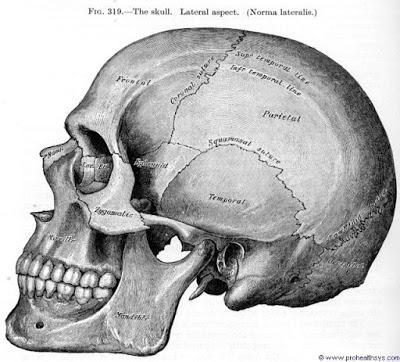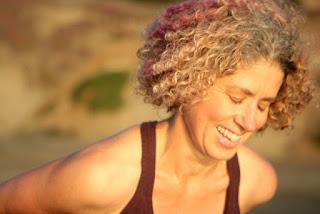 Q: I have a student with jaw pain. She is a new student and just mentioned it to me at the end of class yesterday. I searched YFHA, but didn’t find anything specific to the jaw, but I may have searched inefficiently.
Q: I have a student with jaw pain. She is a new student and just mentioned it to me at the end of class yesterday. I searched YFHA, but didn’t find anything specific to the jaw, but I may have searched inefficiently. I will ask if she has a diagnosis, but do you have any suggested yoga practices specifically for the jaw? I teach neck and shoulder stretches, but have not done much work specifically for the jaw. I sometimes lead my students in Lion’s Pose and we will do self-massage for the face, but any other suggestions? Thank you for any help you can provide!
A: When I got this email, I immediately thought of fellow Bay Area yoga teacher and specialist in all things jaw-related, Cantor Shachoy. She was kind enough to address this question and a few others I had for her. Here’s a condensed version of our interview. —Baxter
Baxter: Cator, thanks for agreeing to share some of your experience and wisdom on the subject of jaw pain with us! Obviously, we don’t really know what diagnosis or the source of this particular person’s jaw pain is. But can you tell us what the two or three most common reasons are for jaw pain in those you have worked with and a little bit about each condition?Cator: Let me start by mentioning my perspective on this topic. In addition to being a long-time yoga and mindfulness instructor, I am also a Craniosacral practitioner. Craniosacral bodywork has a unique understanding of the jaw, which is that it is intimately intertwined with the rest of the body. Much of what I have to offer with regards to yoga and working with the jaw comes from my training in Craniosacral Therapy (CST), and applying these principles to yoga practice.
The three most common causes of jaw pain that I work with are:
1.TMJ/TMD: Pain of the temporomandibular joints, located just below the ear on either side of the face. This may be caused by clenching, grinding, structural imbalance (e.g. scoliosis), car accidents or other whiplash (bicycling accidents, sports, etc.), slips and falls, braces, dental work, or other accidents. Hormones, emotions, and trauma can also be factors.
2. Sinus Pain: The upper jawbones, the maxilla, are hollow bones. They have a cavity or sinus in them. When the sinuses do not drain properly they can become heavy, dull, painful, and prone to infection. Sinuses may become blocked due to clenching, inflammation, environmental sensitivities, headaches, muscle tension or spasm, structural imbalance, or injuries as listed above with TMJ.
3. Compressed Teeth: This may be caused by clenching or grinding, a fall or blow to the head, or other causes, and may result in infection or need for a cap, crown, or tooth removal, replacement, or root canal if unaddressed.
Baxter: Are there some common approaches to these most common causes of jaw pain, in regards to the use of yoga tools or other mindfulness practices? And, if so, can you share a few with us? And is our curious yoga teacher safe to do those things she mentioned above?Cator: Here are some basics for working with the jaw (we all need a lot of reminding so these can be repeated many, many times):
1. The upper and lower teeth should never touch unless you are actively chewing food. Through bringing conscious awareness to the habit of clenching during the day, we can learn to release the lower jaw so that teeth are no longer touching. This takes frequent reminding for awhile, and it can be said many times in the same yoga class, or practiced throughout the day by taking a few minutes three to five or more times a day (morning, noon, night and a couple other times) to notice what's going on inside your mouth. Invite the lower jaw to release away from the upper jaw, creating space between upper and lower teeth.
2. Practice modified Lion Face pose. Lion Face pose is most often practiced by taking the facial structure to extremes—mouth and eyes open as wide as possible with tongue fully extended, and head and neck often thrust forward. If someone's jaw is tight and painful, they may not be able to open wide, and it could cause some damage if they are not careful. Likewise neck tension may be affecting their jaw (see section on cross connections below).
Instead, practice opening and closing the mouth slowly, in a range that feels comfortable. Use the action of opening and closing as a means for investigating what feels good, what does not, and what happens. Is there any clicking, popping, crackling in the jaw joint? Slow down a little. Don't force. If you pay close attention you can even notice when the jaw action influences the neck. You may notice slight twinges and right-left pulls. This gives more info about the neck-jaw connection. Small movements and relaxed muscles will reveal more than extreme movements and tension.
3. Practice breath awareness. When we are clenching, it's very difficult to breathe into the lower belly. Conversely, if we are breathing freely in the whole of the torso, we will be less likely to clench. Begin to notice your breathing habits. Three to five times a day, stop, and just notice where you are breathing—belly, ribs, or collarbones?
Three-part breathing is a simple yoga practice to reset breathing patterns. We will breathe into these three different areas for three breaths each: lower belly (between navel and pubis), lower ribs/upper abdomen (breathing diaphragm), and upper ribs/collar bones. Place the hands below the navel. Beginning with the out breath, breathe all the way out. When out turns to in, send the breath here, allowing the belly to stretch and fill more than normal. If your belly is tight, it's okay to apply a little effort to really expand the belly. Practice this for three breaths, and then return to normal breathing.
Next, move to base of ribs, with palms on firm ribs and fingers on soft (upper) belly. Invite the ribs to expand forward and to the sides. After three breaths, return to normal breathing.
Finally, place hands on upper ribs, with index fingers close to the collarbones, thumbs close to armpits, and other fingers spread across upper chest. Invite the collarbones to lift and upper ribs to expand. Exhaling, release the air without collapsing the chest.
At each location, focus on only breathing in that area. For example, when at lower belly, don't worry about breathing into chest and ribs. At your collarbones don't breathe into lower ribs and belly. Keep the jaw relaxed and teeth apart. Breathe through either the nose or mouth, whichever is easier.
4. Work the cross connections. There are a lot of cross connections between the jaw and other areas of the body, which means you can influence the jaw by improving posture, alignment, strength and flexibility in other areas of the body. Important cross connections include the upper neck, the shoulders, and the pelvis.
Jaw-Neck: The fulcrum for movement of the jaw, i.e., opening and closing the mouth, is between C1 and C2 (joints in the cervical spine). This is known as Guzay's Theorem. This means that the neck and jaw are directly influencing one another every time we open and close the mouth. This is a very important fact for yoga teachers to know. If a student has jaw tension, they will have upper neck tension. If they have upper neck tension, they will have jaw tension. These two can't really be separated. On the plus side, if we work to release the upper neck (for example, through passive traction in Downward-Facing Dog pose), this can have a positive impact on the jaw, if we remember to relax the jaw. It will be less effective if we are unconsciously clenching. A simple reminder to open the mouth slightly and relax the jaw can help a lot.
Shoulders-Jaw: Stabilize the shoulder girdle and invite passive traction (or gentle extension if upright) of neck and head. Keep teeth apart and jaw relaxed. You could also do this in Downward-Facing Dog, for instance.
Pelvis-Jaw: Opening the hips with awareness of the jaw can provide a lot of benefits when working with jaw tension. Practice a modified Lion Face pose (i.e., explore gently opening and closing the mouth to invite release of neck & jaw) while in standing poses and hip openers to remind yourself of the pelvis-jaw connection.
And as to whether our questioner is safe to do these things, I believe so. The Buddha coined a term "ehipassiko," which translates to, "Come and see for yourself" or “Don't just take my word for it, check it out!” I encourage teachers to try out the suggestions I am offering. See whether they work on your own body. Get to know your own patterns, and see what is helpful and what isn't. Then share your best practices with your students.
What I am offering comes out of my experience. I have tried to focus on simple, accessible tools—there's a lot more we can do with yoga asana once we get the fundamentals of jaw awareness going. I hope this is helpful. I am curious as to whether these tools work for you. I'd love to hear from you. I keep learning about what works and what doesn't. Send an email to [email protected] to let me know your best practices—what worked, and what didn't.
Baxter: I don’t know if you have had the same experience as I have, but many of my students with these sorts of symptoms will often have them for quite a while and have not yet seen a doctor to get it medically evaluated. What sort of encouragement do you give to those folks?Cator: Jaw pain/tension can be treated through a variety of modalities. Working together with your doctor and/ or dentist, Craniosacral bodywork is an excellent gentle non-invasive modality for treating many sources of jaw pain. Once we have a clearer sense of what is going on, you can learn self-help techniques, including yoga, mindfulness, conscious relaxation and self-facial massage, which can all support your recovery.
Baxter: I know you offer workshops on jaw issues-do you have any upcoming events that interested folks, at least in the Bay Area, could take advantage of?
Cator: Yes! My Relieve Jaw Tension through Yoga & Mindfulness Workshop is coming up at a couple locations around the bay this spring:
1. Sunday, April 23, 1:30-4:30p @ California Yoga Center in Mountain View, CA
2. Sunday, June 4, 2-5pm @ The Mindful Body in San Francisco, CA
Baxter: Cator, thanks for sharing this information and ideas around jaw pain with us!
Subscribe to Yoga for Healthy Aging by Email ° Follow Yoga for Healthy Aging on Facebook ° Join this site with Google Friend Connect

